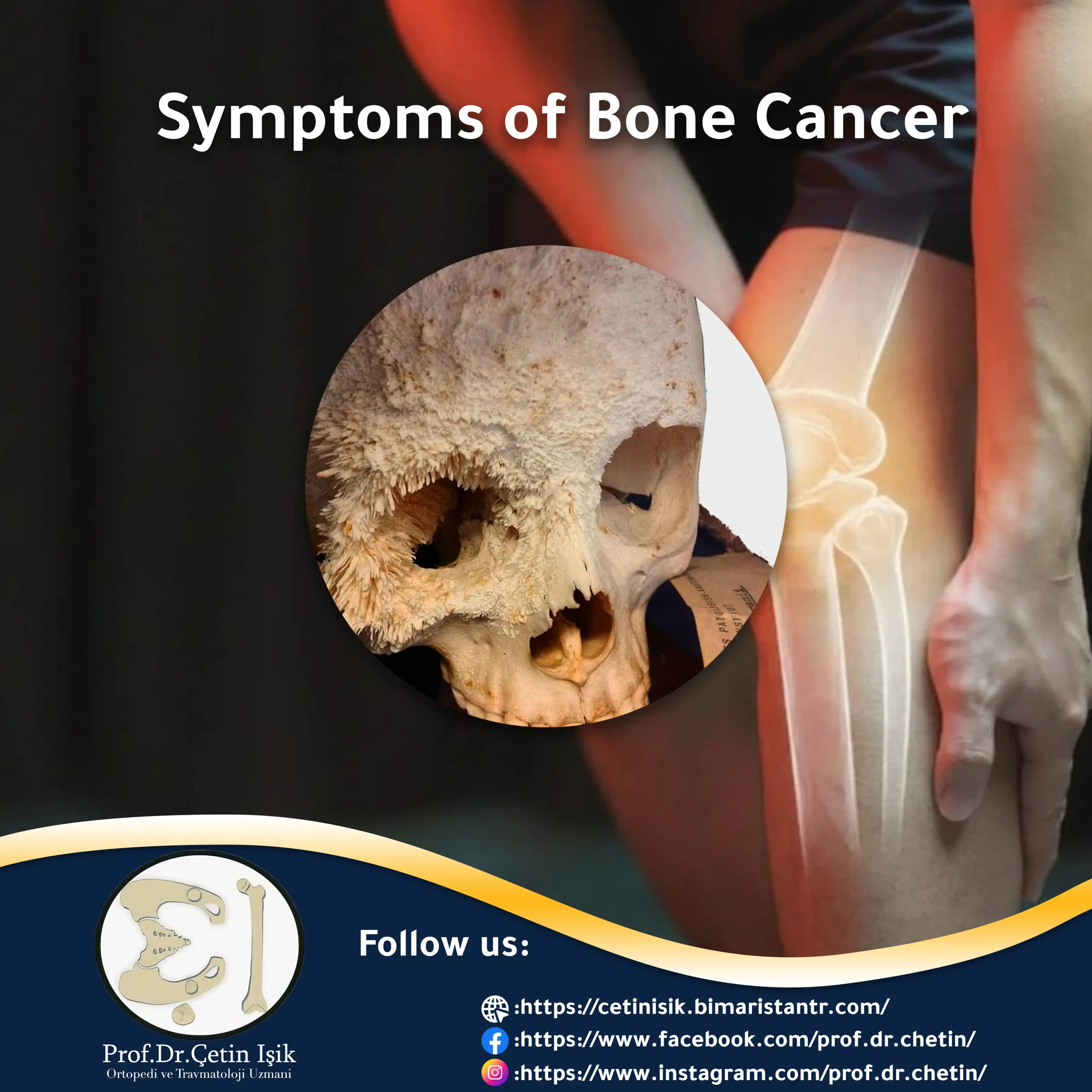Bone cancer is a serious and life-threatening type of cancer, and the symptoms of bone cancer usually involve not only the bone, but blood also. It is a chronic disease that requires treatment for long periods.
What is bone cancer?
When tissue cells divide abnormally and randomly at a specific site, they form a mass called a tumor. Bone tumors arise at the expense of bone-forming cells and may come from other parts of the body.
As the tumor grows, it increases in size and may press on healthy tissue next to it, or it may produce hormones and chemicals that cause various symptoms of bone cancer.
Not all tumors are cancers. There are two types of tumors; The first is benign tumors, which are the most common and are characterized by their inability to spread or give metastases and are not life-threatening or cause serious problems, but they are still abnormal tissues as they are often removed before they grow to large sizes that cause the classic symptoms of bone cancer.
The second type of tumors are malignant tumors or cancer, and it has the ability to spread to more than one tissue and cause severe symptoms and its treatment requires great time and effort.
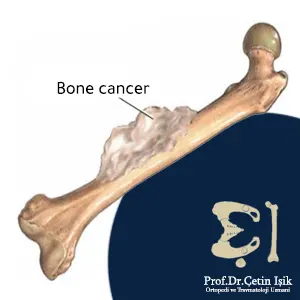
As for tumors in the bones, they are classified into three types:
- Primary bone tumorsIt arises at the expense of bone-forming cells and is uncommon. It is seen in children and adolescents. There are more than 60 types of them. Symptoms of bone cancer occur in varying degrees.
- Haematological malignancies: Any blood cancers that start in the bone marrow, usually affect older people and are more common than primary tumors. Some types of these cancers have symptoms of moderate and severe bone cancer.
- Metastatic cancersAlso called secondary bone cancers, it is seen in elderly and middle-aged patients, and tumor cells reach the bones from many places through the blood and lymph.
Bone cancer requires special attention andDistinguished experience To follow up and treat it
A glimpse into normal bone structure
The healthy bones of the body carry weight without problems and they also resist external influences by separating the hardness of the outer layer called the dense bone, and this layer is surrounded by fibrous tissue called the periosteum, followed by this a layer of spongy bone, which may contain a medullary cavity filled with the soft and brittle bone marrow.
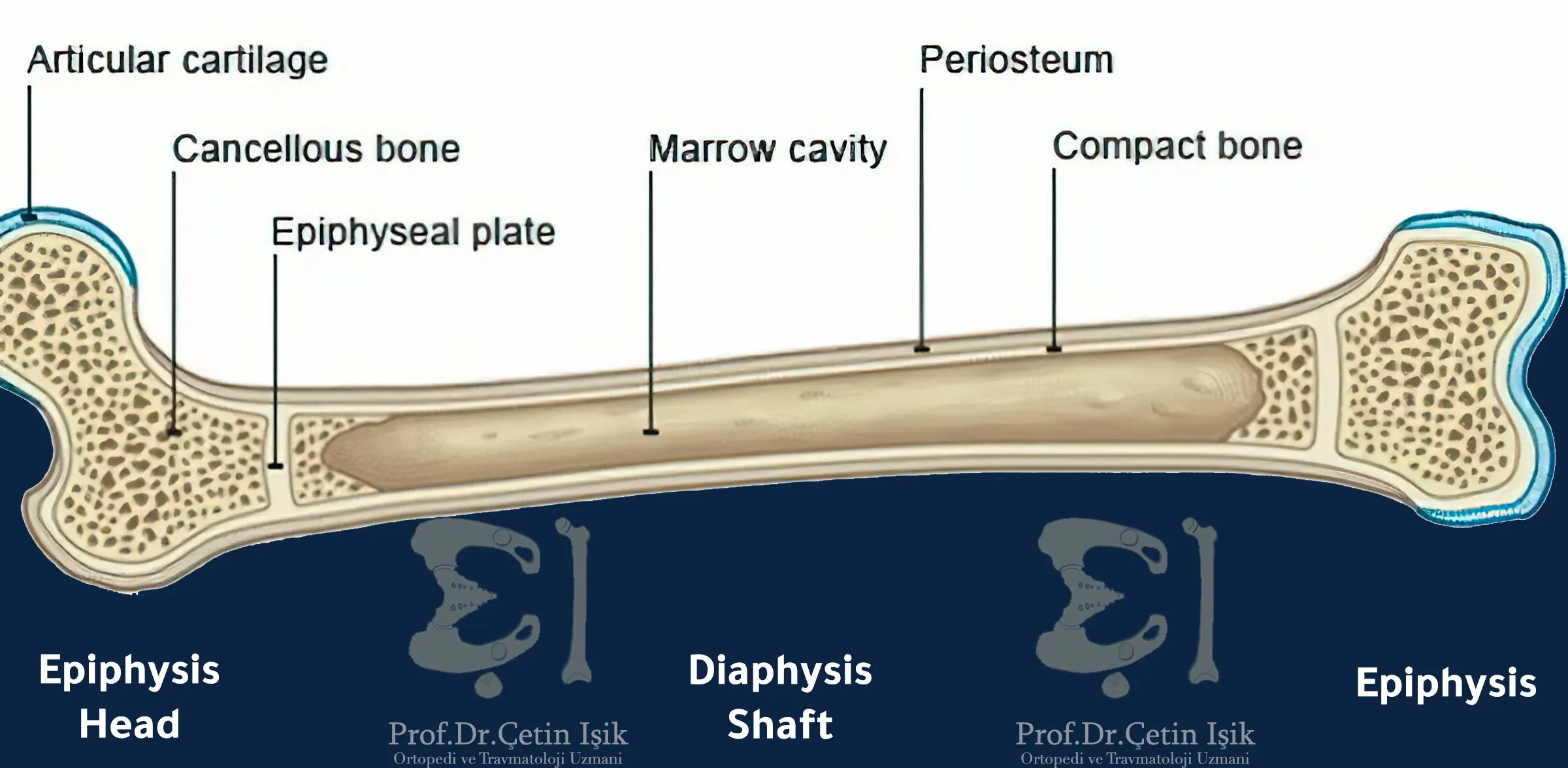
The bone of the child at birth is soft and contains cartilage as a whole, after which the ossification process occurs naturally with the growing of the child, and the cartilage is mainly found after puberty in the joints and the ends of the ribs, in addition to some special structures such as the nose, ear and throat.
Bone contains two types of cells:
- osteoblastsThese are the cells that form new bone tissue.
- osteoclasts: cells that dissolve and sip bone.
The marrow also contains many types of cells such as fat cells and blood-forming cells, all of which may result in cancer and give symptoms.
types of bone cancer
primary cancer
As mentioned previously, this type of tumor begins in the bones and is known as osteosarcomas, and it has many types, including:
- OsteosarcomaIt is the most common type of primary cancer, most often affects people between the ages of 10 and 30 years, and is seen in men at a higher rate than in women, with mild symptoms and little pain.
- Ewing sarcomaIt is the second most common primary cancer in young adults, and it is rare in people over the age of 30. It spreads among white people, especially and affects the pelvic bones, chest and long bones.
- Chondrosarcoma: It arises at the expense of cartilage and is considered a benign tumor mostly, but there are some less common malignant forms such as malignant mesenchymal sarcoma and clear cell sarcoma. The grade and malignancy of the tumor is determined after biopsy.
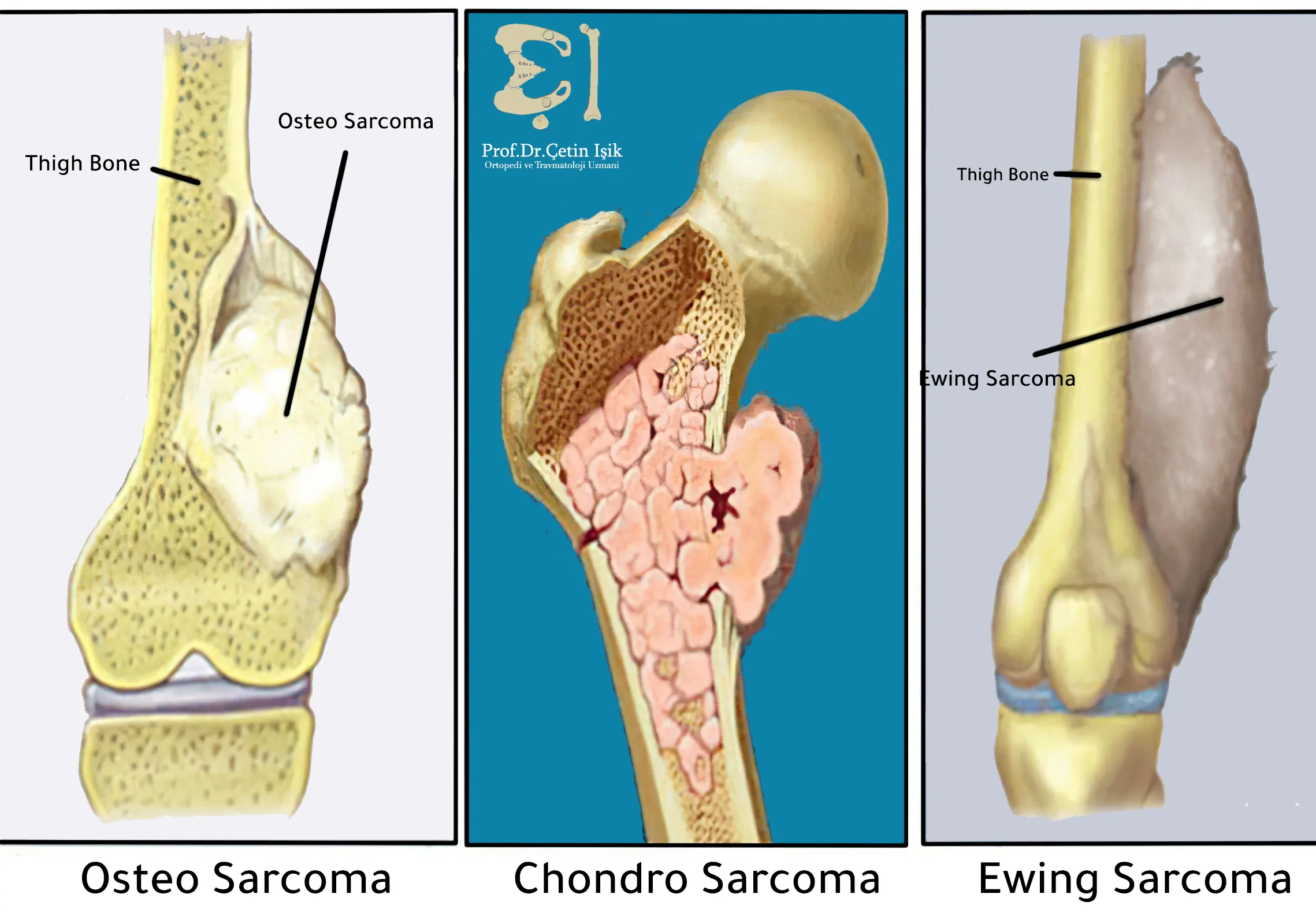
It is also noted that many forms of benign swelling originate in or near the bones and do not cause the worrying and severe symptoms of bone cancer, including:
- Non-ossifying fibroma
- Simple osseous cyst
- osteochondroma
- large cell tumor
- Fibrous dysplasia
- chondrosarcoma
- Bone aneurysmal cyst
These lesions usually cause mild symptoms of bone cancer and some of them appear in the early stage, such as the patient feeling mild pain and swelling within the affected bones and the possibility that signs and symptoms may not be seen until the tumor grows to large sizes.
blood cancer
What is the relationship between bone cancer and leukemia? In fact, the production of blood cells begins in the bone marrow, which is located in the medullary canal in the bones. Therefore, a person with leukemia often suffers from symptoms of bone cancer for a period of time, such as osteoporosis, persistent pain, and the possibility of bone fracture.
Blood cancers that originate in the bones:
- Multiple mycelium: It is the most common cancer that begins in the bones. It is a highly symptomatic cancer that arises at the expense of myeloid cells in the soft tissues of the medullary cavity and is sometimes incorrectly classified as a primary cancer of the bones.
- LeukemiaA malignant disease that begins in the bone marrow and causes severe pain.
- Non-Hodgkin's lymphoma: It is considered a blood cancer that arises at the expense of cells and lymph nodes, in rare cases, the beginning is in the bones.
Secondary cancer (metastatic bone cancer)
A cancer that begins in a specific area of the body, such as the internal organs, glands, etc., and then moves from the affected area until it reaches other organs, such as the bone, is called a metastatic cancer. About 50% of malignant cancers that appear outside the bones give bone metastases.

With the improvement of treatment methods for many types of cancer such as breast cancer, lung cancer, prostate cancer and others, the possibility of the disease spreading to other places and causing symptoms of bone cancer increased because patients of these cases in the past died early before metastases formed.
Among the most common types of cancer that metastasize to bone:
- breast cancer
- lung cancer
- thyroid cancer
- Uterine and ovarian cancer
- Prostate cancer
- Melanoma of the skin
- stomach cancer
Metastases are common in the vertebrae, pelvic bones, bone of legs and arms.
People at risk of bone cancer
There are no clear and direct causes for the occurrence of cancer, as it is a multifactorial disease, meaning that many indirect causes contribute to its initiation and are called risk factors.
Scientists have found that some changes in the DNA of bone cells have led to the development of cancer, through specific genes:
- oncogenesExcessively doing their work leads to the occurrence of cancer.
- tumor suppressor genes: Failure to function of these cells allows cancer to emerge.
Risk factors increase the incidence of cancer, and different types of cancer can have different risk factors, with cancers of completely unknown risk factors.
The most common risk factors that most bone cancers share include:
- Getting old: Especially malignant tumors such as chondrosarcoma.
- familial diseasesLike familial chondrosarcoma.
- tuberous sclerosisA hereditary disease caused by a genetic defect and is uncommon.
- Benign tumorsLike a osteomas.
- Paget's disease of boneIt affects the elderly and makes their bones fragile.
- Exposure to therapeutic radiationResult of second cancers.

Symptoms of bone cancer:
The symptoms of bone cancer are diverse across different cancers, so it will be discussed here as simple as possible and how they can be differentiated, especially those that arise at the expense of the bone cells themselves.
Sometimes the symptoms of bone cancer are not explicit symptoms that the patient notices, especially in the early stages, and the doctor can detect the disease through distinctive signs that differ from one patient to another.
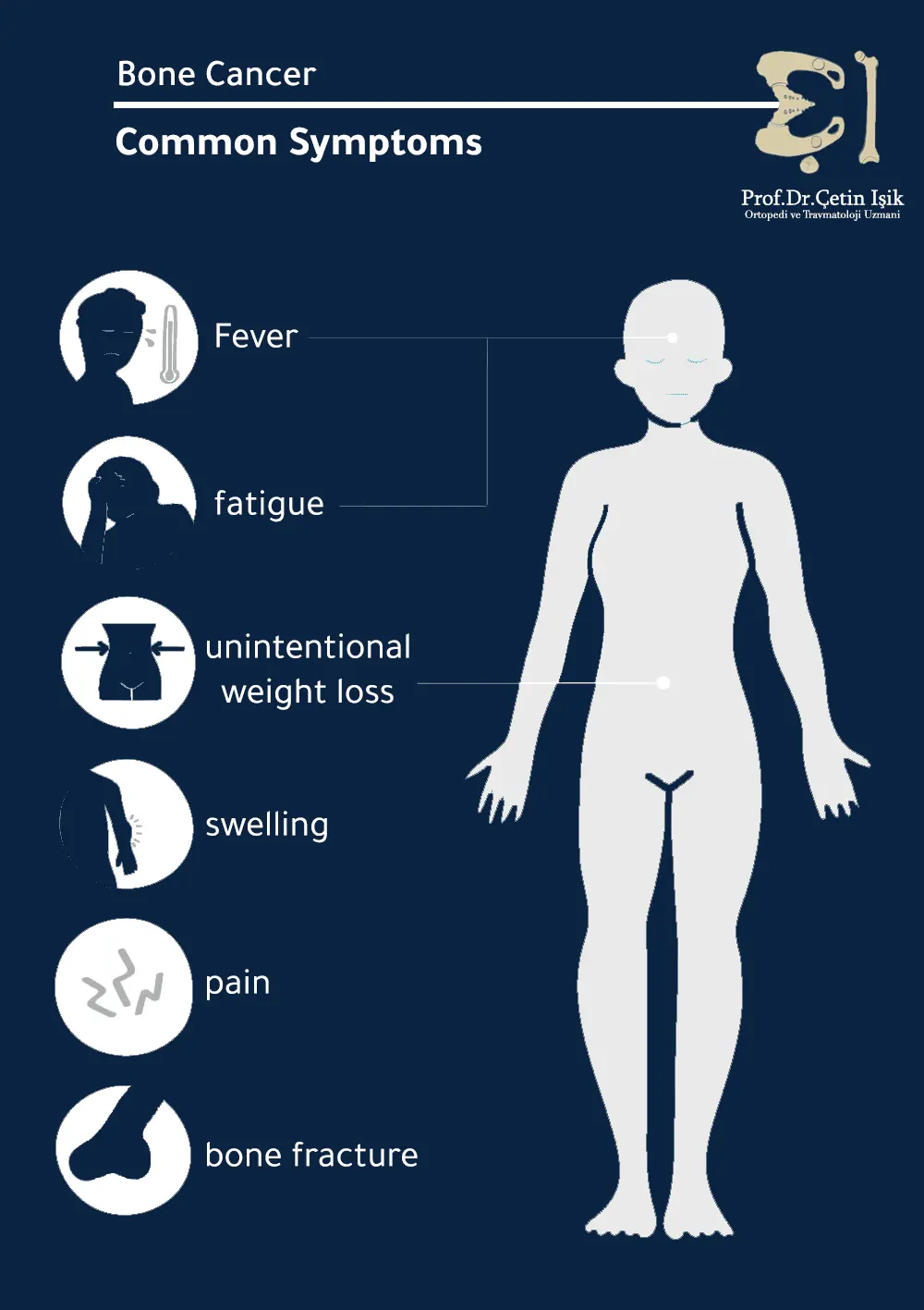
In general, a person with bone cancer may complain of pain, which has special features:
- Pain that occurs at the site of the swollen bone
- The pain is not sharp but vague
- The pain becomes worse during exercise or excessive physical activity
- The pain may awaken the patient at night
People with bone cancer may have a fever, weight loss, fatigue and difficulty moving.
In the advanced stages, the pain becomes worse, and the cancer destroys normal bone tissue, making fragile bones at risk of fractures.
It is possible to see the symptoms of bone cancer when a second disease occurs, such as the bone pain observed in leukemia and vice versa, as some bone cancers cause distinctive symptoms such as anemia, swelling of the limbs and lameness when walking.
You can Contact us Learn more about the symptoms of bone cancer and how to treat it.
Sources
- American Society of Clinical Oncology
- American Cancer Society
- National Cancer Institute
- Medline Plus
Common questions
The average cure rate for localized cancer is 90%, and for metastatic cancers, the cure rate is between 75% and 23%.
Most bone tumors take years to cause obvious symptoms and are slow growing.
The five-year survival rate after diagnosis is .8, meaning that nearly two-thirds of patients live more than five years, and some of them go on to live normally.
It is difficult to predict the occurrence of cancer in the absence of obvious symptoms and risk factors such as age and genetic diseases that cannot be changed, so there is no effective way to prevent bone cancer.
One of the biggest symptoms of bone cancer is pain that is intense at night.


